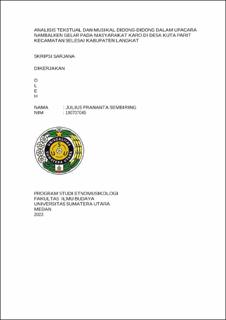Analisis Tekstual dan Musikal Didong-Didong dalam Upacara Nambalken Gelar pada Masyarakat Karo di Desa Kuta Parit Kecamatan Selesai Kabupaten Langkat

Date
2023Author
Sembiring, Julius Prananta
Advisor(s)
Naiborhu, Torang
Sebayang, Vanesia Amelia
Metadata
Show full item recordAbstract
This research discusses the textual and musical Didong-didong in the Nambalken Gelar ceremony in the Karo community. The aim of this research is to analyze the stages and forms of the Nambalken Gelar ceremony as well as the use and function of Didong-didong. The method used in this research is a descriptive qualitative research method. In this research, the author uses the theoretical approach to the basics of music analysis pioneered by William P. Malm. And using theory (Nettl, 1964: 68) which provides two approaches, namely: analyzing and describing what is heard and describing what is seen and writing it on paper in a certain way of writing. In analyzing the function of Didong-didong, the author applies the theory of 10 musical functions introduced by Alan P. Merriam. And to analyze the form of the ceremony, the author uses the theory of traditional ceremonies pioneered by Koentjaraningrat, which has several elements such as: the place where the ceremony takes place, the time the ceremony is held, the objects and equipment of the ceremony, and the people involved in the ceremony. The results of this research show that during the Nambalken Gelar ceremony there was a Didong-didong song sung by Perkolong-kolong. This song contains messages, hopes and prayers for the child whose name is written. The melody form in this song is the same but the verses are different. The conclusion obtained from this research is that Didong-didong is a song among the Karo people in Langkat which must be sung during the Nambalken Gelar ceremony in Langkat Regency.
Collections
- Undergraduate Theses [308]
